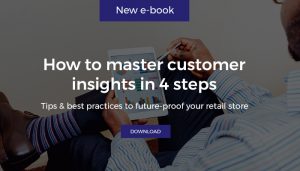Consumers today don’t differentiate experience by online, mobile, social, or store. On the contrary, they have a holistic perception of the brand and demand a smart, fast and personalized experience whenever and wherever they interact. So, when a customer enters your brick-and-mortar store, he/she expects the same level of experience and convenience as when shopping online.
How can modern retailers meet these rising customer expectations for seamless and relevant experiences at every touchpoint?
There are numerous ways for a brand to effectively connect with customers during their visit to the physical store. In this blog post, you will find tips and best practices on how to master the in-store experience and create customers for life.
A rising trend: Buy-Online, Pick-Up-In-Store (BOPIS)
As today’s customers strive for convenience, there is a growing number of those who choose to make a purchase online and then collect their order in store. So, digital channels can drive in-store traffic, and reverse.
According to a recent Forrester research, 40% of US online adults reported using “buy online, pick up in-store” or “reserve online, pick up in store” options when shopping online. The same report revealed that digital touchpoints influence more than half of all in-store sales which indicates that an online presence is essential to retailer success.
This growing trend is forcing brands to rethink their strategy and adapt a unified approach. They need to reimagine their physical stores for the digital age and provide seamless in-store experiences in order to make lifelong shoppers.
Related: Loyalty transformation: Reinventing loyalty for clicks and mortar
Make real-time recommendations
In the fast-paced world of retail, businesses should automate key processes and use in-store technologies to take the in-store experience to the next level. Powerful tools like proximity marketing, beacons, email marketing automation and product recommendation engine can help you connect with customers through targeted messages on mobile at exactly the right time. Through these tools and advanced technologies, you can detect consumers’ smartphones and send them ads, loyalty coupons or other product information.
Make sure your marketing campaigns remain relevant and personalized. How? Read our next tip!
Use data for extreme personalization
Leading the customer experience means transforming insight into action. Use data to add personalization to every step of the customer journey. From placing your customer’s name into the subject line to next level personalization with post-purchase offers and real-time product recommendation while in-store based on customers’ past purchases, using data to go beyond the basics and truly connect with shoppers is the only way to win.
Use customer data to fuel real-time contextual marketing campaigns and connect data-driven customer insights to improve operations and enhance the customer journey.
Extra tip: Remember to stay relevant across all channels. Consistency and convenience not only build but also maintain trust, meaning more loyal customers for your business.
Related: Why you need unified data
Design an attractive loyalty program
There are many ways to collect consumer’s data. But customers today demand to receive value in exchange for their personal data. This is why loyalty programs have become so important to modern businesses.
Loyalty programs are a reliable way to capture data in the physical store and one of the most effective ways to drive repeat purchases and boost brand loyalty. Top retailers reinforce their customer retention efforts by investing in loyalty programs that incentivize customers during their store visit. Loyalty programs also help retailers understand customer motivations, collect valuable loyalty insights and add value to the shopping experience.
Related: Why you need an omnichannel loyalty program
Build a Clientelling app
Customers today are in control. They are digital-savvy and they often have more knowledge about products and brands than the sales associates.
So, you need to properly train your personnel in order to be able to handle every customer in the most effective way and understand why customer experience is very important to the brand.
Make every interaction in-store memorable by investing a clientelling app. Through the app, store associates can enhance engagement and future store visits by sharing personalized looks, and sending product, sale and promotion information via SMS or e-mail messaging.
See how INGLOT’s Beauty Rewards, an award-winning loyalty program, used our Clientelling app to enhance the in-store experience for its beauty fans. Download the case study here.
To do so, you need to have a platform that enables you to access rich content and get actionable insights in real-time, directly to the sales associate’s hands. Read on to learn how retail tech investments are the secret to providing superior experiences at your brick-and-mortar-store.
Choose the right in-store marketing platform
To successfully combine all the above-mentioned actions and make them a reality, you need to invest in technology. While most retailers use different tools to reach their customers at different channels (mobile, store, e-shop), such as email marketing platforms, marketing automation, and CRM, leading retail brands have long understood the importance of having one unified platform to manage and marketing to their customers.
Of course, all these tools are important to retail marketers, but having a single cloud platform to manage all these interactions is more effective and less time-consuming. The right in-store marketing platform integrates with existing marketing systems for more powerful results.
Retailers can now collect customer data from multiple sources including data from loyalty programs and translate them into actionable analytics. They can have a single customer view and optimize the shopping experience more efficiently. Make sure your platform enables you to run automated multi-channel campaigns, eliminating human mistakes and only focusing on what really matters; your customers.
Bottom line: Customers today expect brands to understand them. Retailers need to use technology to leverage data and get a deeper understanding of their best customers. They also need to reconsider enhancing the brick-and-mortar experience by providing convenience and personalization, focusing not only on transactions but on the customers’ emotions too. Brands that do these, are the ones equipped to survive.








